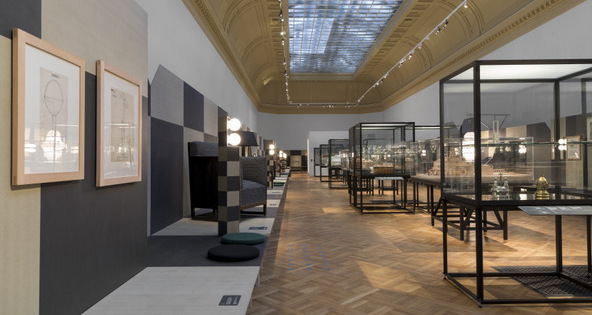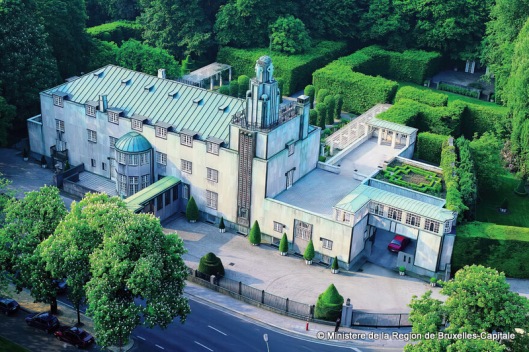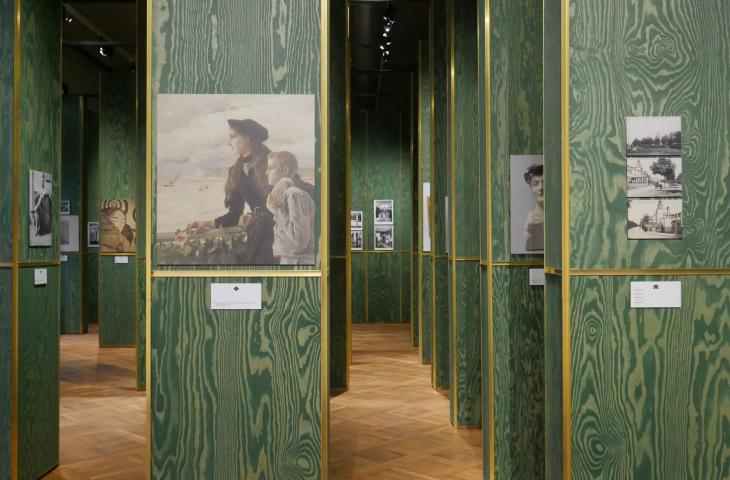Tags
Ans Persoons, Art Nouveau Architecture, Falling for Beauty, Furniture Design, Josef Hoffmann, Salettl, Stoclet 1911 Restitution, Stoclet Palace, Wiener Werkstätte
“The exhibition JOSEF HOFFMANN – Falling for Beauty at the Art & History Museum in Brussels provides an exceptional opportunity to discover an artist who regarded beauty as an essential element in individual and social transformation. This retrospective, the first dedicated to Hoffmann in Brussels, aims to offer a deeper analysis of the artist’s ideals and their evolution, both due to and independently of the various ideological and social circumstances in which they took shape.

The exhibition presents a range of well-known works as well as several rare pieces from private collections. The narrative is interspersed with biographical details and new analyses of aspects that were previously overlooked, thus deepening our understanding of this central figure in the modern movement. The exhibition is developed in collaboration with the Applied Art Museum of Vienna (MAK) and can be visited until 14 April 2024.”

Falling for Beauty – Josef Hoffmann Exhibition
The official introduction of the exhibition Josef Hoffmann, Falling for Beauty gave me a rather insatiable appetite to race to Brussels and get face-to-face with all those beautiful – the known and particularly the unknown – pieces. And of course for learning all about the aspects that I “previously overlooked, thus deepening my understanding” of Josef Hoffmann. So off I went to Brussels in January 2024, only to discover I was a bit dissapointed. Why? I don’t know. Maybe I have already seen too much? Maybe I have visited too many museums? Or maybe I am just not such a fan of Josef Hoffmann as I thought I was? Probably, the truth lies somewhere in the middle…
Josef Hoffmann (1870-1956)
The thing with Hoffmann is, his career lasted 60 years. He worked from approx. 1895-1955 and of course his style evolved constantly. And basically, I only like his designs from the first decade or two. At least, that is what I discovered at the exhibition. One aspect that I dó appreciate very much about Hoffmann is that he was so innovative. Just look at his designs! The man was at least 100 years ahead of his time! Objects he designed in his early years still appear very modern today.
Personally, I enjoy the applied arts and architecture a bit more than the traditional fine arts (painting and sculpting). So watching some of the best designs Hoffmann created in his early years, was fun. I particularly liked his early chairs. And having lived in Japan for a while myself, I can always appreciate a good example of Japonism, like Hoffmann’s ‘Japanese’ cabinet. It reminds me of a sitting samurai.
When Hoffmann got older, and commissions got fewer due to the economic circumstances (economic crisis in 1939 and eventually WWII) he drew more and more semi-utopian follies, or salettls (garden pavilions/gazebos). In the 1980s, students of the Viennese University of Applied Arts were assigned to turn Hoffmann’s Salettl designs into scale models, and they are shown here at the exhibition for the first time. From his later designs, I probably found these to be the most interesting to discover.
The exhibition presents Hoffmann’s work in six chronological chapters. Each time-frame centers around one or more architectural models. And for each chapter a text panels provide information about that particular period in Hoffmann’s life. I have tried to photograph those panels so you can also ‘deepen your understanding’. (Download pdf: Gallery Texts). There is a lot more information on his wiki-page though! Having read all the panels, I was unpleasantly surprised by the fact that Hoffmann was rather friendly with the Nazis. Even more so because nobody seems to hold that against him today. The documentary at the end of the exhibition was actually the most informative. It lasted almost one hour and I really enjoyed it!

Stoclet Palace, Brussels | Photo by Wim Robberechts
Stoclet Palace
Hoffmann’s most important achievement is without a doubt the spectacular Stocklet Palace, at Avenue de Tervueren 279-281 in Brussels. The Palace was commissioned by Adolphe Stoclet (1871–1949), a wealthy Belgian banker and art collector. Hoffmann got carte blanche and involved the entire Wiener Werkstätte when he created his Magnum Opus. Its austere geometry marked a turning point in Art Nouveau, foreshadowing Art Deco and the Modern Movement in architecture.

View of the Dining Room at Palais Stoclet
The interior of the building is decorated with marble paneling and an abundance of artworks, including large mosaic friezes by Gustav Klimt (designed by him and implemented on location by Leopold Forstner) and murals by Ludwig Heinrich Jungnickel. Hoffman and his colleagues designed every aspect of the mansion, down to the door handles and light fittings. This cooperation between the architect, artists, and artisans makes Stoclet Palace a perfect example of a Gesamtkunstwerk, one of the defining characteristics of Art Nouveau architecture.

I am sure a visit to the Stoclet Palace is on every Art Nouveau lovers bucket list. Why? First of all, because it is impossible. And you know what happens when things are impossible. You want them even more! The Stoclet Palace has never been open to the public and there is a disagreement between Stoclet’s four granddaughters as to the future of the Palace. Politicians in Brussels have started to mope over the fact that it is not open to the public, even though is has been uninhabited since 2002 and placed on UNESCO’s World Heritage List since 2009. Secretary of State Ans Persoons is working on a ordinance to enforce all UNESCO heritage sites in Brussels that are not open to the public, to open their doors for at least ten days a year. This is mainly to persuade the heirs of the Stoclet family to open the Stoclet Palace.
In the mean time, there is some good news for everyone who wishes to see the interior of the Palace: at the end of the Hoffmann exhibition is an additional exhibit about Stoclet Palace. The aim of this exhibit and the digital reproduction, presented as a film, is to take visitors on a tour of the interiors of Stoclet Palace. The virtual reproduction is based on archival sources and a detailed architectural analysis. The project kept a team of experts busy for almost two years. Some footage can already be seen in below video about the exhibit.
The Stoclet exhibit was a nice appetizer, and the design of the exhibit was beautiful. But I really want to see the real thing. Now even more. So when you get to the end of the Hoffmann exhibition and watched the Hoffmann video, enter the gallerie on your right to enjoy the Stoclet exhibit while you can. And who knows, I may get back to you sooner than you know, with my own pictures from inside the Stoclet Palace…
Josef Hoffmann – Falling for Beauty
& STOCLET 1911 – Restitution
Art & History Museum, Brussels
6 October 2023 – 14 April 2024
Continue Reading:
Brusselse regering verplicht opening UNESCO-erfgoed
Digistory: Josef Hoffmann (1870–1956)
Google Arts & Culture – Gustav Klimt and the Palais Stoclet
Inside Art Nouveau – Stoclet Palace
Josef Hoffmann – Falling for Beauty
Josef Hoffmann – Progress Through Beauty (Exhibition at the MAK)
Josef Hoffmann – The Quest for Uniqueness (PDF)
Kijk voor het eerst binnen in het luxueuze Stocletpaleis video
Le Palais Stoclet a “ouvert ses portes” grâce à une visite virtuelle et immersive
UNESCO – Stoclet House
Speels en veelzijdig: architect en designer Josef Hoffmann
STOCLET 1911 – Restitution
WikiArquitectura – Stoclet Palace
Wikipage – Stoclet Palace











